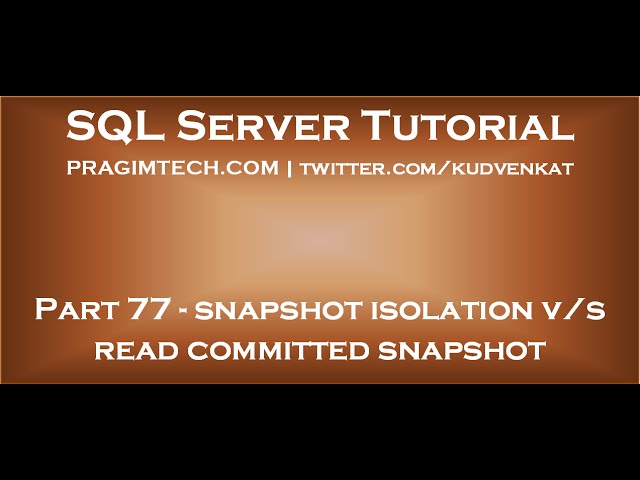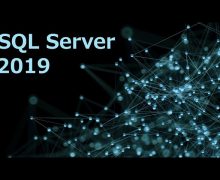
Difference between snapshot isolation and read committed snapshot

Text version of the video
http://csharp-video-tutorials.blogspot.com/2015/08/difference-between-snapshot-isolation.html
Slides
http://csharp-video-tutorials.blogspot.com/2015/08/difference-between-snapshot-isolation_24.html
All SQL Server Text Articles
http://csharp-video-tutorials.blogspot.com/p/free-sql-server-video-tutorials-for.html
All SQL Server Slides
http://csharp-video-tutorials.blogspot.com/p/sql-server.html
All Dot Net and SQL Server Tutorials in English
https://www.youtube.com/user/kudvenkat/playlists?view=1&sort=dd
All Dot Net and SQL Server Tutorials in Arabic
https://www.youtube.com/c/KudvenkatArabic/playlists
In this video we will discuss the differences between snapshot isolation and read committed snapshot isolation in sql server. This is continuation to Parts 75 and 76. Please watch Part 75 and 76 from SQL Server tutorial before proceeding.
Update conflicts : Snapshot isolation is vulnerable to update conflicts where as Read Committed Snapshot Isolation is not. When a transaction running under snapshot isolation triess to update data that an another transaction is already updating at the sametime, an update conflict occurs and the transaction terminates and rolls back with an error.
Enable Snapshot Isolation for the SampleDB database using the following command
Alter database SampleDB SET ALLOW_SNAPSHOT_ISOLATION ON
Open 2 instances of SQL Server Management studio. From the first window execute Transaction 1 code and from the second window execute Transaction 2 code. Notice that Transaction 2 is blocked until Transaction 1 is completed. When Transaction 1 completes, Transaction 2 raises an update conflict and the transaction terminates and rolls back with an error.
–Transaction 1
Set transaction isolation level snapshot
Begin Transaction
Update tblInventory set ItemsInStock = 8 where Id = 1
waitfor delay ’00:00:10′
Commit Transaction
— Transaction 2
Set transaction isolation level snapshot
Begin Transaction
Update tblInventory set ItemsInStock = 5 where Id = 1
Commit Transaction
Now let’s try the same thing using Read Committed Sanpshot Isolation
Step 1 : Disable Snapshot Isolation for the SampleDB database using the following command
Alter database SampleDB SET ALLOW_SNAPSHOT_ISOLATION OFF
Step 2 : Enable Read Committed Sanpshot Isolation at the database level using the following command
Alter database SampleDB SET READ_COMMITTED_SNAPSHOT ON
Step 3 : Open 2 instances of SQL Server Management studio. From the first window execute Transaction 1 code and from the second window execute Transaction 2 code. Notice that Transaction 2 is blocked until Transaction 1 is completed. When Transaction 1 completes, Transaction 2 also completes successfully without any update conflict.
–Transaction 1
Set transaction isolation level read committed
Begin Transaction
Update tblInventory set ItemsInStock = 8 where Id = 1
waitfor delay ’00:00:10′
Commit Transaction
— Transaction 2
Set transaction isolation level read committed
Begin Transaction
Update tblInventory set ItemsInStock = 5 where Id = 1
Commit Transaction
Existing application : If your application is using the default Read Committed isolation level, you can very easily make the application to use Read Committed Snapshot Isolation without requiring any change to the application at all. All you need to do is turn on READ_COMMITTED_SNAPSHOT option in the database, which will change read committed isolation to use row versioning when reading the committed data.
Distributed transactions : Read Committed Snapshot Isolation works with distributed transactions, whereas snapshot isolation does not.
Read consistency : Read Committed Snapshot Isolation provides statement-level read consistency where as Snapshot Isolation provides transaction-level read consistency.
Transaction 2 has 2 select statements. Notice that both of these select statements return different data. This is because Read Committed Snapshot Isolation returns the last committed data before the select statement began and not the last committed data before the transaction began.
In the following example, both the select statements of Transaction 2 return same data. This is because Snapshot Isolation returns the last committed data before the transaction began and not the last committed data before the select statement began.
Read Committed Snapshot Isolation
No update conflicts
Works with existing applications without requiring any change to the application
Can be used with distributed transactions
Provides statement-level read consistency
Snapshot Isolation
Vulnerable to update conflicts
Application change may be required to use with an existing application
Cannot be used with distributed transactions
Provides transaction-level read consistency









![C++ Tutorial [104] – Smart Pointer: shared_ptr GERMAN](http://www.coderswebsite.com/wp-content/uploads/2016/08/c-tutorial-104-smart-pointer-sharedptr-german-youtube-thumbnail-70x70.jpg)













Social